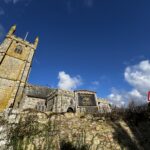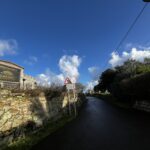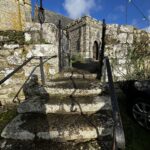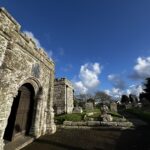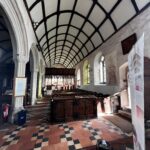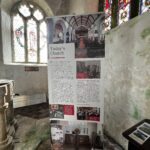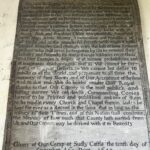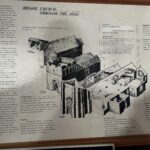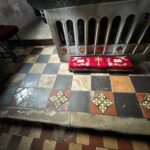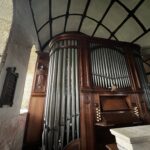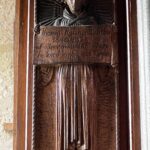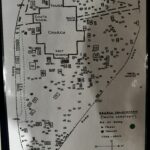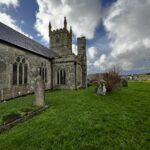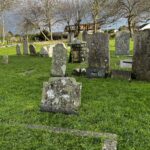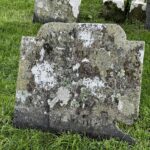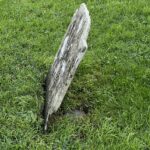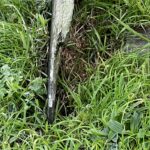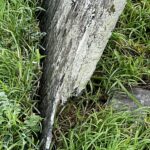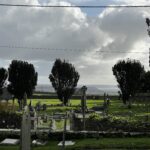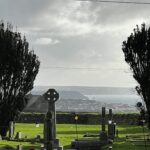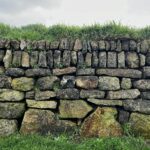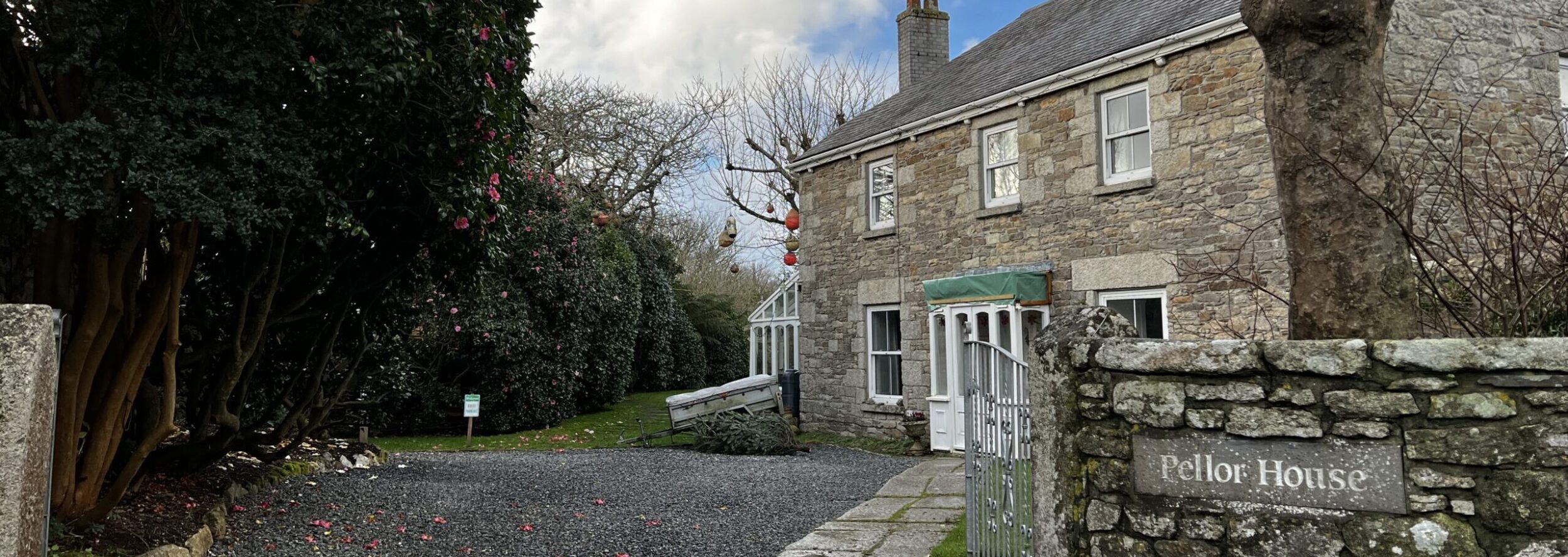
As I mentioned in my post about Germoe, Breaca was the sister of Germochus, a Celtic king. They were part of a band of Irish holy missionaries who arrived near the Hayle Estuary around 600 AD. From there, they traveled along the waterway to its source at Tregonning Hill, a landmark that likely stood out against the dense woodland. St. Breaca eventually settled on a hillside where a Celtic settlement from the Bronze and Iron Ages once stood, in the area that is now known as Breage. Meanwhile, Germochus made his home in the valley where Germoe now lies.
My visit to Breage took place on a sunny, yet chilly afternoon. Just like my drive to Germoe, I headed east on the A394 towards Helston. As I approached Breage, the church’s bell tower emerged from the landscape, visible from half a mile away as it rose above the village. Breage church, like its neighbor Germoe, is part of what was once the Godolphin Estate.
I parked in front of the old mortuary and made my way up the stone steps into the church. The first thing that caught my eye was the old floor tiles, which bore a striking resemblance to those in the entryway of Germoe Parish Church.
Tucked away off an aisle in the church is a pipe organ with a sign beside it that reads: “Thomas Robins Bolitho (1840-1925) of Trengwainton, where he loved to play the organ.” After his passing, the organ was gifted by his widow to Truro Cathedral, where it was placed in the North Transept. In 1967, it found a new home in this church, where it continues to fill the space with its resonant tones.
One of the most striking artifacts in the church is a letter from King Charles I, prominently displayed on a large board. This letter was written by the king to express his gratitude to the people of Cornwall for their unwavering support during the English Civil War, even when other, more powerful regions had faltered. He ensured a copy of this letter was sent to every church and chapel in Cornwall to be read aloud and displayed. Many of the churches I visited during my trip had this letter on show. Sadly, six years after penning this letter, King Charles I was executed, bringing an end to the monarchy for 11 years between 1649 and 1660.
Near the organ, I found a table with several binders offering a detailed guide to the churchyard burials, including an alphabetical list and a location map. This was incredibly helpful, as the weather over time has taken a toll on the headstones, making many of them almost impossible to read.
One grave, in particular, stood out to me: Grave #62 – Gideon & Jane Polkinghorne
Jane was born Jane Lemon, the first child of Samuel Lemon and Margaret Nicholas, my 7x great-grandparents, making Jane my 6x great-aunt. If you’ve read my post on Germoe and the Great Work Mine, you’ll recognize Samuel as Jane’s father. Jane grew up in rural Germoe and married Benjamin Rowe Cornish in 1761 when she was just 17. They had six children together before he passed away. Jane then married Gideon Polkinghorne, with whom she had seven more children. Twice widowed, Jane lived a long life, passing away at the age of 90 in 1834. She and Gideon lived in the hamlet of Trew, just north of Breage. Interestingly, there was a recent proposal to locate a new underground tin mine beneath this hamlet, a move opposed by many locals. Without the parish burial register, it would be difficult to identify Jane’s headstone today. It’s weathered and worn, showing signs of thinning, cracking, and leaning, and may not remain upright for much longer.
As I stood at their grave, I looked out towards the sea, the distant coastline of Gunwalloe stretching down to the Lizard Peninsula. I only realized the elevation when I saw that the landscape all seemed to slant down to the sea.
Separating the cemetery and the farmer’s fields is a fieldstone wall. I’d seen quite a few in Cornwall so far, but I stopped to really admire the craftsmanship that went into it – however many years ago it was built. Each stone is unique, yet together they create such a uniform, beautiful structure – fascinating!
Before leaving Breage, I took a walk down the road from the church, past the local pub, toward Pellor House. This wasn’t just any house—it was the family home of Jane’s brother, Samuel, and his wife Elizabeth, my 6x great-grandparents. From around 1780 until Elizabeth’s death in 1805, they raised their eight children within those walls. As I made my way along the road, I couldn’t help but imagine the countless times they must have walked this same path, perhaps returning from the church or, more often, the pub. This road would have been second nature to them, nothing special, just a walk home.
I slowed my pace, trying to absorb the landscape and surroundings, hoping to capture a sense of the familiarity they must have felt here. The trees, the air, the same rolling hills in the distance—everything about the scene carried an echo of the past. It was a moment of connection, walking in the literal footsteps of my ancestors, and for a brief moment, the distance between the centuries seemed to disappear.
The original part of Pellor House dates back to the 1700s, a time when rural homes in England were often built to last, with thick stone walls and steeply pitched roofs designed to withstand the unpredictable British weather. These houses were typically simple, yet sturdy, reflecting the practical needs of rural life. Many would have been built with locally sourced materials, giving each home a unique character that blended with the surrounding landscape.
Pellor House itself likely began as a modest farmhouse, gradually expanded over the years as the family grew or as prosperity allowed. The gardens, too, would have been an essential part of the home, used not just for aesthetic pleasure but for growing vegetables, herbs, and fruit—an important supplement to the family’s diet. In the 19th and 20th centuries, the house saw additions and renovations that added to its charm and functionality. Recognizing its historical and architectural significance, Pellor House has since been designated a Grade II listed building by Historic England, ensuring its preservation for future generations.
Walking through the ancient villages of Cornwall, tracing the steps of my ancestors, has been an unexpectedly profound experience. Each church, each grave, and each historic home like Pellor House has brought the past to life in a way I never imagined. It’s humbling to stand where my ancestors once stood, to see the same landscapes, and to feel the deep connection to a place that shaped their lives and, in turn, my own. And to think, my trip is only on day 4 of 11 —there’s still so much more to uncover and experience. Cornwall, with its rich history and personal ties, has already left an indelible mark on me, and I can’t wait to see what the rest of this journey holds.

